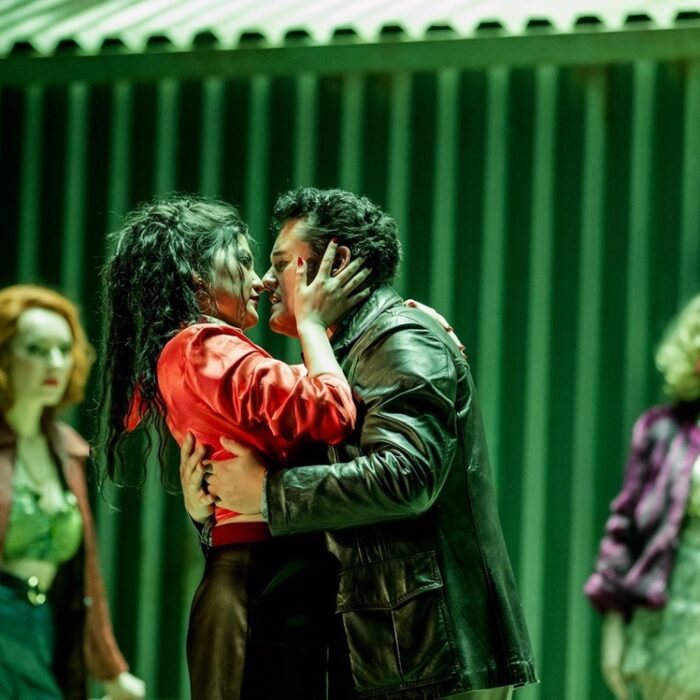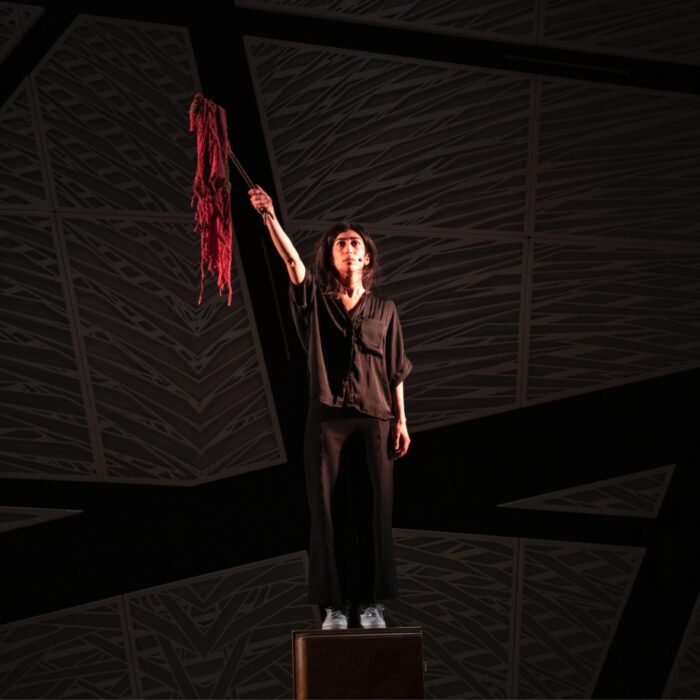
Teatro dell’Opera di Roma 2023-24 Review: La Sonnambula
By Laura ServideiPhoto:
The Teatro dell’Opera di Roma presents a new production of Vincenzo Bellini’s “La sonnambula,” crafted by Jean-Philippe Clarac and Olivier Deloeuil, boasting a stellar cast. Set in a picturesque Swiss village, the narrative revolves around Amina, a modest young woman on the brink of matrimony to a wealthy landowner. However, her world is turned upside down when she is discovered in another man’s bed. She is a sleepwalker, but the village people don’t know about sleepwalking and accuse her of being unfaithful; consequently, her fiancé calls off the wedding, until the inevitable happy end.
Videos, Callas, and Unclear References
Clarac and Deloeuil adhere to their distinctive approach of transplanting the storyline into the city and the time of the performance, although adapting a plot of this nature to modern-day Rome presents its challenges. To overcome this hurdle, they employ a variety of theatrical layers: Amina, or rather her actress double, is depicted in video sequences exploring a painting exhibition, while the stage features an art gallery named “Elvezia” where pivotal scenes unfold as artistic performances. This approach effectively addresses the problem of portraying modern people who have never heard of the concept of sleepwalking.
The video of Amina depicts her falling asleep in the Hotel Quirinale, adjacent to the Teatro Costanzi, in the suite that Maria Callas occupied during her performances in Rome. Within the program booklet, it is revealed that Amina experiences the entirety of the opera in a state of half-consciousness, on the night before her wedding, experiencing the events of the plot as in a dream. The videos interlace renowned paintings featuring sleeping figures, juxtaposed with the actress portraying Amina mimicking these iconic poses. The program booklet also informs us that the directors aimed to delve into the multifaceted nature of sleep, including its erotic connotations and the symbolic parallels drawn between sleep and death.
However, these intricate layers failed to resonate clearly, resulting in a production that felt disjointed and perplexing. The pervasive presence of the video elements served more as a distraction than elucidating the narrative. Moreover, the excessive homage paid to Maria Callas, ranging from depictions of her iconic performances on Rome theater posters to videos showing the “Maria Callas” suite at the Hotel Quirinale, as well as photographs of her impersonating Amina, struck a chord of poor taste. Instead of enhancing the production, they seemed to attempt to draw inappropriate comparisons.
Two Sopranos for One Role
The musical aspect of this performance was considerably more enjoyable. The role of Amina was originally written for Giuditta Pasta, a so-called soprano sfogato, which could be described as a mezzo with considerable ease in the upper register. However, it eventually evolved into a virtuosic showcase for coloratura sopranos during the late 19th and early 20th centuries. These singers embellished the score with extravagant personal variations, often prioritizing high-flying displays, until Maria Callas reclaimed the role, infusing it with renewed depth and significance. Lisette Oropesa, undeniably a coloratura soprano, offered an interpretation that was poignant, evocative, and introspective. Her shimmering, luminous soprano voice, ideally suited for bel canto, effortlessly navigated the demands of the score. She delivered sparkling, flawless coloratura passages, breathtaking chromatic scales, and a vibrant, thrilling trill. However, these vocal feats were not mere showcases of her technical prowess; rather, they were wielded in service of the music and character portrayal.
Oropesa’s rendition of “Sovra il sen la man mi posa” in Act one was electrifying, brimming with cascading coloratura fireworks, yet imbued with the innocence and exuberance of a young woman on the cusp of marital bliss. The love duet with John Osborn (Elvino), “Son geloso del zeffiro errante,” emerged as a highlight, with both singers infusing their performances with heartfelt emotion; Osborn conveying loving jealousy, while Oropesa responded with reassuring tenderness. A superb performance.
Following the intermission, an announcement revealed that Lisette Oropesa would be unable to continue performing in the second act due to a sudden indisposition. In her place, Ruth Iniesta, from the second cast, stepped in to take on the role. The news came as a surprise to the audience, since Oropesa had exhibited exceptional form up to that point. Transitioning into a performance under such unforeseen circumstances is undoubtedly challenging, yet Iniesta demonstrated remarkable professionalism as she assumed the role for Act two. Her soprano voice possessed a warm, golden quality, slightly more centered in the mid-range. While some of her high notes lacked clarity, especially at the outset (understandably), Iniesta’s rendition of the cantabile “Ah, non credea mirarti” displayed a commendable legato, and she navigated the demanding coloratura passages of “Ah, non giunge” with confidence.
Stellar Cast Highlights
John Osborn’s vocal timbre resonated beautifully with the character of Elvino. He skillfully blended his head voice with a sort of captivating falsettone, imbuing it with a robust and masculine quality. Osborn’s tenor exhibited impressive agility, effortlessly reaching the soaring high notes, including the two demanding high Cs in the cabaletta of the duet “Prendi, l’anel ti dono,” with apparent ease.
His voice exuded a natural melancholic hue, perfectly suited to the emotional depth of Elvino’s character. Osborn’s thoughtful manipulation of dynamics elevated the lyrical passages to remarkable heights, rendering them among the most poignant moments of the performance. His rendition of the aria “Tutto è sciolto” in Act two was particularly poignant, stirring the audience’s emotions.
Roberto Tagliavini portrayed Count Rodolfo, the enigmatic stranger whose arrival in the village sets the drama in motion. His bass voice resonated with strength and clarity across the entire range, yet he maintained a flawless bel canto style and displayed exquisite elegance throughout. Tagliavini imbued his aria “Vi ravviso, o luoghi ameni” with a compelling intensity, delivering impressive, captivating high notes. Moreover, his portrayal was both convincing and entertaining as he charmingly flirted with every girl in sight, adding depth and humor to his character.
Lisa, Elvino’s former flame and Amina’s rival, harbors jealousy towards Amina’s happiness and plots to drive a wedge between the two lovers. Francisca Benitez brought vivacity and just the right amount of malice to her portrayal. While her soprano exhibited some sharpness in the higher register, she delivered both of her arias with success, capturing the essence of her character’s scheming nature.
Veteran Monica Bacelli inhabited the role of Teresa, Amina’s mother, with a warm and velvety mezzo-soprano voice that exuded maternal warmth and tenderness. Despite the limited stage time, Bacelli commanded attention with her charisma, leaving a lasting impression on the audience.
Tenor Mattia Rossi, as Alessio, smitten with Lisa, and Bass Giordano Massaro, as il notaro, rounded out the cast with commendable performances, contributing to the overall excellence of the production.
Orchestra e Coro del Teatro dell’Opera di Roma Highlights
The chorus plays a pivotal role in this opera, functioning akin to a Greek chorus, providing commentary on the unfolding events while also actively participating and propelling the action forward. The Teatro dell’Opera di Roma’s chorus delivered a commendable performance, particularly shining in the opening of Act two with the chorus “Qui la selva è più folta ed ombrosa,” demonstrating well-considered dynamics and exquisite phrasing.
However, there were occasional instances where the tempo faltered, albeit infrequently. The chorus’s performance was somewhat hampered by a staging choice that often had them seated on either side of the stage or standing, limiting their physical involvement. Overall, the stage direction lacked depth, with singers frequently performing in isolation, even during the intimate love duets. A lengthy table was placed center stage, with singers occasionally climbing onto it to deliver their solos—a clichéd and uninspired idea. This concept proved problematic when Benitez, wearing five-inch stiletto heels, lost her balance while climbing. Fortunately, a quick-thinking chorus member prevented her from falling, allowing her to seamlessly continue her aria without missing a beat. Kudos to her resilience and professionalism.
Francesco Lanzillotta conducted the orchestra of the Teatro dell’Opera di Roma with an affectionate and reverent approach to the score. He maintained brisk tempi, propelling the action forward with a rich and expansive sound.



